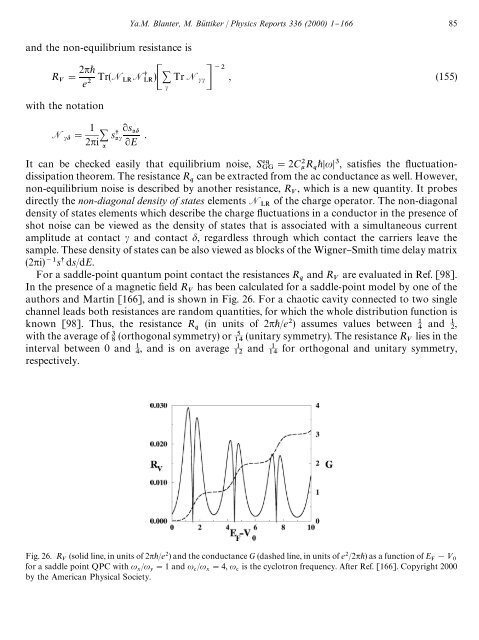shot noise in mesoscopic conductors - Low Temperature Laboratory
shot noise in mesoscopic conductors - Low Temperature Laboratory
shot noise in mesoscopic conductors - Low Temperature Laboratory
You also want an ePaper? Increase the reach of your titles
YUMPU automatically turns print PDFs into web optimized ePapers that Google loves.
and the non-equilibrium resistance is<br />
Ya.M. Blanter, M. Bu( ttiker / Physics Reports 336 (2000) 1}166 85<br />
R "<br />
2<br />
e Tr(N N ) Tr N<br />
<br />
<br />
, (155)<br />
with the notation<br />
N "<br />
1<br />
2i <br />
Rs<br />
s <br />
RE<br />
<br />
.<br />
It can be checked easily that equilibrium <strong>noise</strong>, S "2CR , satis"es the #uctuation-<br />
<br />
dissipation theorem. The resistance R can be extracted from the ac conductance as well. However,<br />
<br />
non-equilibrium <strong>noise</strong> is described by another resistance, R , which is a new quantity. It probes<br />
<br />
directly the non-diagonal density of states elements N of the charge operator. The non-diagonal<br />
<br />
density of states elements which describe the charge #uctuations <strong>in</strong> a conductor <strong>in</strong> the presence of<br />
<strong>shot</strong> <strong>noise</strong> can be viewed as the density of states that is associated with a simultaneous current<br />
amplitude at contact and contact , regardless through which contact the carriers leave the<br />
sample. These density of states can be also viewed as blocks of the Wigner}Smith time delay matrix<br />
(2i)s ds/dE.<br />
For a saddle-po<strong>in</strong>t quantum po<strong>in</strong>t contact the resistances R and R are evaluated <strong>in</strong> Ref. [98].<br />
<br />
In the presence of a magnetic "eld R has been calculated for a saddle-po<strong>in</strong>t model by one of the<br />
<br />
authors and Mart<strong>in</strong> [166], and is shown <strong>in</strong> Fig. 26. For a chaotic cavity connected to two s<strong>in</strong>gle<br />
channel leads both resistances are random quantities, for which the whole distribution function is<br />
known [98]. Thus, the resistance R (<strong>in</strong> units of 2/e) assumes values between and , <br />
with the average of (orthogonal symmetry) or (unitary symmetry). The resistance R lies <strong>in</strong> the<br />
<br />
<strong>in</strong>terval between 0 and , and is on average and for orthogonal and unitary symmetry,<br />
<br />
respectively.<br />
Fig. 26. R (solid l<strong>in</strong>e, <strong>in</strong> units of 2/e) and the conductance G (dashed l<strong>in</strong>e, <strong>in</strong> units of e/2) as a function of E !< <br />
for a saddle po<strong>in</strong>t QPC with / "1 and / "4, is the cyclotron frequency. After Ref. [166]. Copyright 2000<br />
by the American Physical Society.
















